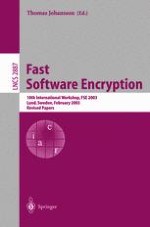2003 | Buch
Fast Software Encryption
10th International Workshop, FSE 2003, Lund, Sweden, February 24-26, 2003. Revised Papers
herausgegeben von: Thomas Johansson
Verlag: Springer Berlin Heidelberg
Buchreihe : Lecture Notes in Computer Science
Enthalten in: Professional Book Archive
